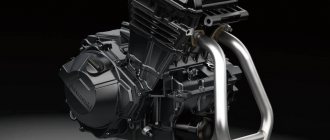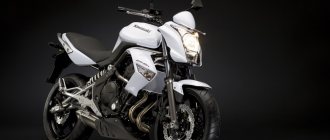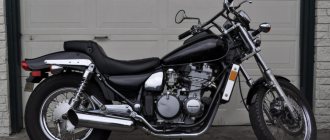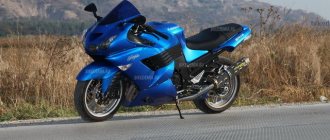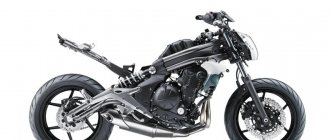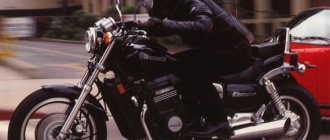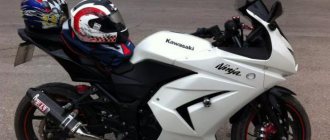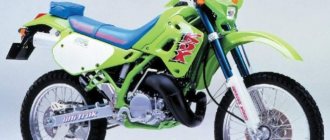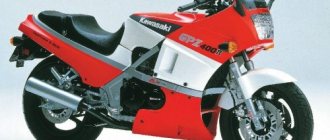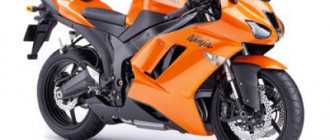08/11/2021 If you decide to buy a motorcycle, but don’t know where to start, we advise you to read our review. We will try to bring clarity to your mind - we will outline the design features and technical characteristics of different types of motorcycles, and tell you about the reasons for the appearance of each of them. Together we will figure out why this or that “iron friend” should be yours. In this matter, we will rely not on intuition, but on facts, including historical ones.
We'll bring a motorcycle from the Japanese auction!
Free consultation
What types of motorcycles are there?
A clear division of motorcycles into types does not exist to this day. It’s also difficult to name how many types of motorcycles there are. But there is an opportunity to find out why this type of vehicle has a fairly extensive classification and what became the “starting point” of today’s conditional classification.
The motorcycle became especially popular at the beginning of the 20th century. In transport, users of that time liked the sporty spirit, mobility and low cost of a motorcycle. As you know, demand creates supply. Therefore, at this time, many companies begin to conduct engineering development of new motorcycle technology.
The work does not go unnoticed: the world learns what pneumatic tires, electric lighting, spark ignition, chain drive, soft suspension, etc. are. The motorcycle gradually acquired all this, turning from a bicycle with a motor into a solid, durable and reliable transport vehicle. means.
With the advent of design schools in the States, England, Germany and Italy, motorcycles began to be ranked into groups. The main classification - on-road and off-road - remains the same. With the introduction of motorcycles into racing, various types of sports motorcycles emerged alongside cars.
The modern classification of motorcycles ranks them according to purpose, weight, engine size, control method, number of wheels, etc. Let's delve into the topic and see what the rapid development of motorcycle technology has led to, let's go over the main types of modern motorcycles and find out their "tricks" .
Who are bikers?
A lot of people call themselves bikers. Are there any criteria and rules for who can be considered a biker and who cannot? If there are rules for motorcycle clubs, then perhaps there are rules for the exact definition of this word "biker", which many use in a variety of meanings.
It’s worth reminding that all the rules, traditions, motorcycle and club life originate in America. It was there that this culture was born, based on the love of freedom, the motorcycle, and a sense of brotherhood and the conquest of space.
Anyone who rides a motorcycle, scooter or trike is called a rider. Rider is a common word for everyone and it is synonymous with the word motorcyclist. Since the motorcycle appeared first, and all its other varieties (scooters, trikes, etc.) much later, the word “motorcyclist” means the person driving this vehicle. The term "rider" acquired the same meaning as motorcyclist a little later, as it originally meant a person on a horse.
The history of the appearance of the word “biker” has several different semantic origins. On the one hand, the first motorcycle clubs were created at the beginning of the last century on the basis of bicycle clubs. And the word “biker” carried the meaning of belonging to a motorcycle club.
The second birth of the word “biker” was the 60s, when the press drew attention to motorcycle clubs and the word “biker” hit the front pages of newspapers and magazines. This was the time when this word came into common use again, more widely, and along with the growing popularity and number of motorcycle clubs, it began to acquire new concepts, becoming more clear and defined.
Based on this layer of traditions and motorcycle culture, we can formulate four main criteria that determine a rider who can be called a biker, and he himself can consider himself one. The concept of “biker” has a philosophical meaning and therefore some ideas are based on established traditions.
- A biker rides a large road motorcycle. It should be added that motorcycles are divided into two groups - road and recreational motorcycles. Motorcycles for fun are cross-country, enduro, sports and everything else, including sports versions intended for tourism. Since bikers recognize only one "proper" road motorcycle - the Harley-Davidson, then a biker must ride a Harley. Of course there are exceptions to this rule. But these are exceptions due to poverty. For example, in our country it is difficult to buy a Harley, or build a custom one, for little money.
- The biker repairs and maintains his motorcycle himself. The rule here is: Nobody touches my bike or my woman! Only the biker takes care of his motorcycle. He does all the operations himself, from changing the oil to overhauling the engine. Typically in America, bikers have several motorcycles and all or some of them are built with their own hands or rebuilt from stock Harleys. While working on his motorcycle, the Biker realizes his vision of the motorcycle and creates his spiritual idea in technical embodiment. Motorcycle knowledge is an integral part of being a biker. Of course, not everyone can do everything themselves at once. But even if you have friends who will help and advise you, then you must do everything with your own hands. For a biker, servicing or modifying a motorcycle is not a necessity, but a need. He finds great pleasure in this.
- Motorcycle culture (biking and motorcycling) is an integral part of the life of a biker. Knowledge of motorcycle culture, history, traditions and rules of conduct are considered essential for a biker. For Biker, the concepts of freedom, respect, and brotherhood are not empty words. These concepts permeate his life every day and every hour. A biker lives a motorcycle life, regardless of the weather, season and other reasons in life. For a biker, the motorcycle and everything connected with it always comes first and is the red line.
- The biker is actively involved in the motorcycle life and does something for the motorcycle community. His activities can be very diverse, but never confined to a narrow circle of people. The areas of application of this activity are also very wide. This could be: introducing newcomers to the motorcycle world, culture and traditions, organizing and holding various events, training young riders, or simply providing human assistance to members of the motorcycle community. The scope of activity is limitless, but it is done by the biker as a motorcyclist and a representative of the best part of the motorcycle community, with all the responsibility.
As a rule, common interests lead to bikers uniting in clubs, which, again, in accordance with tradition, are called motorcycle clubs. The term "biker club" does not exist; it is a designation used by the general public or the press, but never used by members of the motorcycle community.
In particular, almost all motorcycle clubs classified as MC require the use of Harley as part of their membership conditions. Other points, although not strictly defined, are provided for, thereby ensuring the composition of the MS from bikers.
Many motorcycle clubs, especially in our country, do not have the opportunity to have a Harley. Many clubs that consider themselves motorcycle clubs are actually rider clubs that use motorcycle paraphernalia and symbols.
We wrote about various motorcycle and rider clubs, their differences, forms of management and organization.
In our country, the motorcycle movement is just developing and many established rules and traditions are just beginning to take root. It is too early to talk about the widespread spread of this culture. That is why there is confusion and confusion in the minds of many. Many people call themselves bikers when they are not. The most obvious example of such “non-bikers” are RUBs (Rich urban bikers). RUBs are wealthy Harley owners who have all the appearance of real bikers, sometimes behaving, especially in groups, attracting attention and even provocatively. However, apart from their external similarity, they have nothing in common with real bikers. But this group is not the only one guilty of this. Many who started riding a motorcycle, wore leather, began to call themselves bikers.
Representatives of the press call anyone who rides a motorcycle a “biker.”
It is worth noting that even the European, and even more so the American press, use this term more delicately. As a rule, it is used when it comes to clubs and events with a large number of organized riders.
And one last thing. To become a biker you need to go through a certain path, understand a lot and make a choice about the need for this as part of your life.
bikernews.ru
customoto.com
Road
Road or universal bikes that are suitable for riding around the city and covering short distances on the highway. It was with these motorcycles that the story began. The “fathers” of modern models are still very popular and are on par with cars.
It should be noted that calling a particular motorcycle “road” or “classic” is a rather “slippery” topic. For example, the BMW company introduced the term “roadster” into the designation of its road motorcycle models (we’ll talk about it later). Despite the fact that we are talking about purely automotive topics, for several years now many specialized publications have been willingly and boldly using this designation.
Standard
The classic motorcycle or "standard" appeared before the classic car with an internal combustion engine - back in 1886. Until now, it is classified as a vehicle “for every day”.
Classic motorcycles have a special magic; they make their owner fall in love with their grace and at the same time brutality. A motorcycle with a direct pilot seat (saddle height no lower than 85 cm) and a minimum of plastic. A classic bike is usually equipped with a small number of external body kits, but is equipped with lighting equipment - you can really safely move on it on dark public roads.
All types of such road motorcycles:
- equipped with a powerful engine and modernized transmission - suitable for daily driving on city streets;
- have the same size rear and front wheels - this feature makes it easier to move on an asphalt road;
- They are distinguished by universal rubber - the combined tread is suitable for traction on any type of road.
Honda CB750
An example of a legendary classic model is the Honda CB750 motorcycle from 1969 from the Land of the Rising Sun. At the time of release, this samurai was able to revolutionize the market by introducing 4-cylinder engines, which confidently replaced the 2-cylinder engine that was popular at that time.
Road retro motorcycles from the 60s and 80s are still popular today. Despite its age, the value of such technology is only growing.
Naked
Naked or “naked” is a type of passenger motorcycle for a beginner. This bike is devoid of fairings, which in classic models traditionally cover the engine and frame. The model was created for a typical city dweller who appreciates the maneuverability of equipment - you can easily drive this motorcycle even through narrow passages.
Among the characteristic features of Naked it is also worth noting:
- free access to engine repair work and other basic elements;
- comfortable slightly inclined position of the driver on the seat;
- low speed - you won’t accelerate much on “naked” models.
If we compare the appearance of the motorcycle and its “filling”, we can confidently classify naked bikes as affordable models. The excellent price of motorcycles is due to minimalism in tuning - the costs of the production process spontaneously decrease.
Bobber
It is not difficult to guess what class this motorcycle belongs to. The bobber is a typical road bike. This special type of motorcycle began to appear in the 30s and 40s of the 20th century in the USA. At that time, motorcycle racing on a dirt track was popular. Along with the Harley, the bobber, as a class of motorcycle, has become a cult favorite for many generations of motorcycle connoisseurs.
The “trick” of this model is its simplicity. The seats, headlights, battery and gas tank have all been replaced with lighter counterparts. The essence of this tuning was to reduce the weight of the motorcycle without changing the technical and running parameters.
Over time, the bobber changed, and in the end it became an exclusively sporting attribute. The modernizations turned out to be so successful that for a long time in America bobbers were at the peak of popularity even after the advent of good roads.
The modern bobber has lost some of its charm. Today, a model may have an unusually high fork and a bulky, disproportionate muffler. A bobber in the 21st century is more pathos than practicality.
We'll bring a motorcycle from the Japanese auction!
Request a call
Roadster
Roadsters combine the chassis geometry of classic bikes with high-torque two- or four-cylinder engines. The seat height of the new type of motorcycle does not exceed 65 cm - you can sit in it not only upright, but also quite low, which increases the level of comfort over long distances.
Roadsters were created for high elasticity and dynamic power development. The model has a low curb weight: the engine chassis, frame and windshield are not covered. Since there is no skin, you won’t be able to drive at a constant speed of 160 km/h on a roadster.
The mixture of a bike and a car quickly became popular. There are three explanations for this - an unusual design that attracts attention on the road, good technical solutions, as well as a desire to demonstrate one’s wealth - such a “toy” costs quite a lot.
Cafe racer
This motorcycle is worth choosing if you plan to regularly ride at high speed over short distances. Cafe racers began to be mass-produced in the United States in 1901. The first cafe racer was created on the basis of the British Triumph Bonneville. This model is still produced, only its stylistic design changes.
The basic advantages of the technology are rapidly developing speed and excellent controllability. However, when choosing such an “iron horse”, you should immediately prepare for a minimum of comfort.
The term "cafe racer" originated in England in the 1960s as an ironic name for motorcyclists who pretended to be "cool" professional racers by parking their vehicles next to a table in a cafe.
Scrambler
One of the most extraordinary types of classic motorcycles is the dual-purpose bike. The scrambler is a stylization of retro technology. It is quite well equipped and was designed for light off-road driving.
Classic road models began to be converted into scramblers. Motorcycles were made easy and motivating. Today, such a motorcycle is not easy to find: they are practically not produced, because they consider the production of “exotic” to be an unprofitable activity.
Ducati Scrambler
The popular company Ducati nevertheless released its Scrambler, and later British manufacturers also caught up. The released bikes fully correspond to their name, however, the list of production motorcycles is still very short.
Oil bike
Stunning power and beauty in metal. This is a laconic, classic-style roadster. Of all types of road motorcycles, it is one of the fastest. On such a bike you can easily win the “traffic light race”. However, it is worth considering that these motorcycles are not inclined to turns and sudden braking.
Yamaha V-Max
It is due to the features of this model that the legendary Yamaha V-Max received the symbolic name “Sledgehammer”.
Before buying an oil bike, you should “try it on for yourself” - sit on it, feel the power and heaviness of the equipment.
https://jplife.ru/statistic/YAMAHA/OTHER/?
Cruiser
Cruisers “changed clothes” from touring motorcycles and immediately became the standard of style. The first cruiser model appeared in the USA in the 40-50s. 20th century, when fans demanded chic and brutality.
Among the characteristic features of such a representative it is worth highlighting:
- complete absence of plastic and abundance of chrome;
- seat height no higher than 75 cm, comfortable saddle, high back;
- U-shaped handlebar, forward-mounted footrest;
- two-cylinder engine, teardrop-shaped tank.
In general, the manufacturers managed to create a motorcycle that gives the feeling of riding not on an open bike, but on a luxury car. Below is a little more detail about what types of such motorcycles there are.
Chopper
The “trick” of American choppers is their expressive appearance. These are not the fastest motorcycles, but they are successfully styled to suit the owner. The main features by which you recognize a chopper: an elongated front fork, a wide rear wheel, a teardrop-shaped tank, a two-level seat and a high steering wheel, as well as leather and chrome in the design.
Power cruiser
He's a dragster. A motorcycle “tailored” for powerful grips especially for those who like cruisers, but don’t like their calm disposition. It's a motorcycle shaped around a motor. If you want pure power with sporty dynamics and a comfortable riding position, there's no better option.
Sports
Motorsports competitions were first organized in 1894. It was from this period that the classification of motorcycles into “civilian” and “sports” or “racing” appeared.
It’s worth noting right away that such bikes are designed for victory, and not for comfort, so riding them is not very comfortable. The driver has to curl up on the saddle or even lie on his stomach. Therefore, if you need a bike for everyday driving on city roads, this is not your option.
The maximum speed that this “beast” develops is 290-300 km/h. The number of engine revolutions is more than 10 thousand.
Streetfighter
This is a class of road motorcycles - the same as a sportbike, however, it is more suitable for city riding. The motorcycle is characterized by high maneuverability, excellent handling, and stability on the trajectory. Victory in the case of this model is not at the forefront. Streetfighter will appeal to those who have wanted change for a very long time, but at the same time are attached to the urban area.
Tourist
Tourers or “limousines” are very comfortable and cost much more than standard ones. Such models appeared to the world relatively recently - as soon as amateurs began to be interested in comfortable motorcycles with many functions.
Ideal transport for tourist trips. Manufacturers of trainers, full trainers, and baggers focus on comfort and safety, de-emphasizing speed and maneuverability. On such a bike you can comfortably ride up to 1000 km per day. Among the distinctive features of motorcycles, it is worth noting a high back, a soft seat, trunks on the sides, and a luggage compartment. Some models are equipped with cruise control, radio, air conditioning, airbags, and a passenger seat.
Sports and tourism
“Sport-tourist” motorcycles are sporty in appearance, but intended for long-distance travel. Such models became popular in the 80-90s of the last century. According to owners' reviews, a sports touring bike should be appreciated for its aggressive design, technology and high speed.
Biker vs Motorcyclist - who is who?
Author: March 29, 2021 08:41
Over the past motorcycle season, I attended bike rallies of various sizes, both international and regional, made many new acquaintances and made many conclusions about biker culture in the vastness of the former USSR. In this article, I will explain in clear language the difference in the concepts of Biker and Motorcyclist and, using examples, I will show why many who call themselves bikers are not bikers at all.
Biker vs Motorcyclist - who is who?
Over the past motorcycle season, I attended bike rallies of various sizes, both international and regional, made many new acquaintances and made many conclusions about biker culture in the vastness of the former USSR. In this article, I will explain in clear language the difference in the concepts of Biker and Motorcyclist and, using examples, I will show why many who call themselves bikers are not bikers at all. And so let's get started! Biker in rough translation from English. This is a motorcyclist, that is, at first glance, the words Biker and Motorcyclist are the same, but in the CIS, these are two different concepts that are radically different! So who is a motorcyclist? This is a person who rides on 2 wheels, regardless of whether it is a 110 cc Chinese moped or an 1800 cc Harley, most motorcyclists are not familiar with the insides of their iron horse, and their travel range does not exceed 100 km. If they travel far, it’s only to motorcycle festivals. Very often they ruin themselves and their equipment by driving at speeds that exceed the speed of their guardian angels. Most of them are either young men who were able to buy a motorcycle with their parents’ money (these are not only 15-year-old boys, but there are also those who are over 30) or men who think that if you buy a motorcycle for more money, they will get a cool chick, but the motorcycle itself Regardless of the cost, it in no way increases the size of the penis or balls. and the most they can count on is girls who will fall for money, and even then not for long. In general terms, we have identified the main characteristics of motorcyclists: those who ride motorcycles, and it makes no difference whether they are a boy from a village in Izha or a businessman on a GoldWing, both are motorcyclists. But who is a biker, you ask? First of all, no matter how strange it may sound, the Bikers now and the Bikers of America in the 50s-80s have something in common. Firstly, a motorcycle for a biker is not just transport, but first of all a faithful friend, or more precisely his brainchild which he himself created and customized for himself. The vast majority of bikers ride custom ones and this is the stereotype of a Chopper in the style of Captain America, outwardly this can be a completely factory motorcycle, but inside it is an ideal machine in which everything works like a clock, every little detail is made with soul and adjusted to the maximum, and most importantly, the motorcycle is completely customized for the owner - all levers, landing, etc. Bikers, in rare cases (when they need to tease their pussy), burn rubber and rev the engine to the cut-off point - this is the lot of motorcyclists. Secondly, Biker is a lifestyle, even otherwise it is a philosophy, for example, even though outwardly he will be a shabby little man with a fume, he will always help his two-wheeled brother in trouble as if he were his best friend, now this is rare, even true friends sometimes betray. I met precisely Bikers and guys of 19 years old in Izhaki and Java, old women: who ride tens of thousands of kilometers on motorcycles, on which many do not even reach the store without breaking down and constantly scold the motorcycle, but the problem is in the person if the hands do not grow from there. And I met a man who is over 50, he has grandchildren, he has a big business, but he stood on the highway and helped set up the carbox for a guy in Java. Have you often seen a Ferrari driver help a guy start a Zhiguli from a tow, haven’t you? So I haven’t met... For example, who is who: some guy during a midlife crisis bought a Harley, bought leather clothes, a biker jacket with stripes, a bandanna with skulls, etc. And standing nearby is a guy on the Dnieper from the 70s in old jeans and a worn helmet from the same years as the motorcycle. And often many people get confused and call a guy a biker, and a guy a motorcyclist, but in fact it’s the other way around. So, until I was in the environment of two wheels, I thought that bikers are those who in brand new clothes ride a brand new motorcycle, but this is just a motorcyclist.
There are always exceptions and what I wrote is just my opinion.
Source:
Related links:
Did you like the post? Support Chips, click:
Partner news
fishki.net
Off-road
It's time to talk about the second class of motorcycles - off-road. Otherwise they are called “dirt bikes” or “dirty motorcycles”. Compared to road vehicles, their design is simplified, they have powerful wheels, a lightweight frame without fairings. SUVs are equipped with all-terrain tires - this ensures excellent traction on unpaved roads. Typically, such motorcycles have a single-cylinder engine, borrowed from cross-country motorcycles.
Next we will talk about the types of such motorcycles and their purpose. They, like road ones, are divided into types completely arbitrarily.
Motocross
Motorcycles of this type were created to participate in various sporting events, in areas where the road does not even smell. Typically, such equipment is equipped with two-stroke engines. Motocross is lightweight, has a durable frame, and reliable suspension. Many models of motocross motorcycles are completely devoid of lighting technology - from a kick starter.
Good news: motocross does not need to be registered with the traffic police. If this is important to you, please pay attention.
Enduro
We are talking about the same motocross, only you can ride it on city roads and register it. The motorcycle is equipped with light optics and has an engine that is not as powerful as a cross-country motorcycle. Enduro also has a conditional division:
- sports motorcycles with powerful engines;
- universal soft enduro;
- typical off-road enduro;
- heavy class motorcycles;
- "parquet" enduro.
Rally
The rally motorcycle has a loud and clear name. They are participating in the toughest motorcycle race in Saudi Arabia. Every year, KTM produces a small batch of rally motorcycles that are as close as possible to the factory prototypes.
KTM 450 Rally Factory Replica 2022
This year, the Austrians did not change their tradition - the KTM 450 Rally Factory Replica 2022 was made with the direct participation of riders Toby Price, Matthias Wallner and Sam Sunderland.
Dual sport
Dual-use motorcycles. With this two-wheeled SUV you can get anywhere on a civilized road or in the wild.
In this category, the 250cc four-stroke is not only the most affordable off-roader, but also the best suited for tackling the wild. They have the ideal size, weight and good fuel consumption.
Trial
Motorcycles that belong to this class are used in sports such as motorcycle trials - a technical sport. Athletes overcome various obstacles and perform variable stunts on a motorcycle. The structure of such motorcycles is unique - they are as light as possible, their engine adapts to the upcoming obstacle and its cubic capacity can be 50-125 cubic meters. Models with excellent traction, reliable frame, energy-intensive suspension.
Track racing
This category of motorcycles is similar to a trial, since it is also created to participate in a competition - racing on a track. This is a specific form of motorcycle racing where teams or individual athletes compete on a dirt oval track. Track racing motorcycles are light, well-controlled and powerful.
Snow bike
A snow bike literally glides on skis and becomes an excellent replacement for a snowboard. It can only be ridden in winter when descending snowy slopes.
The design of such snow motorcycles was revived by the German engineer M. Gfaller. After the war, he created a very practical model of a bicycle-snowmobile. In the 40s, an even more convenient snow bike model appeared, created by E. Brentner. Today the most popular snowbike manufacturer is the Brentner company. It was founded by the grandson of the famous inventor.
Custom
Custom is a non-serial motorcycle that was created in a single copy at the request of the customer. We can confidently say that custom models were born at the same time as classic models. It is impossible to accurately identify the types and characteristics of such motorcycles, because this group includes all motorcycles that are not mass-produced.
A custom can be created on the basis of a chopper or sports bike. This group includes the same dragsters with jet traction that give victory in the race. This also includes types of custom motorcycles such as bobbers and racers.
Not exactly motorcycles
We have looked at the most popular types of American, biker, heavy motorcycles, now it’s worth saying a few words about “not quite motorcycles”. Such transport is usually called “motorcycles”, however, from a theoretical point of view, in terms of technical parameters, they do not belong to this category of vehicles.
Minibike
Otherwise, such transport is called a “pocket bike”. Like karts, the first minibikes were created by enthusiasts in their garages. Their story starts in Japan in the 1950s. At this time, the population organized competitions (races) on homemade miniature bikes. Then minibikes began to be used by technical and maintenance personnel in drag racing.
Despite the seeming frivolity of the vehicle and its small size, many modern minibikes accelerate to speeds of 60-100 km/h. The weaknesses of minibikes are small wheels and weak suspension.
Pitbike
A pit bike is very similar to a cross-country motorcycle, but much smaller in size. Designed for riding in mud or on special tracks. The technical characteristics are more impressive: engine displacement is 100-200 cubic centimeters, power up to 15-20 horses, wheelbase up to one and a half meters and weight up to 80 kg.
Scooter
A scooter is an ideal means of transportation in medium-sized and large cities, as well as in rural areas. It's something between a motorcycle and a bicycle. The advantages of this choice include the following: ease of operation, maneuverability, and low fuel consumption.
Scooteretta
Scooters are the most popular class of motorcycles in the world, but most residents of our country know little about it. This is a scooter with large wheels (43.2 cm in diameter). The engine here is installed under the rider's feet, and not under the saddle, like a regular scooter.
Moped
We are talking about a “close relative” of the motorcycle. Such transport can reach speeds of up to 50 km/h and is convenient for traveling short distances in cities or rural areas. The basic advantage of this choice is budget. The moped is economical in fuel consumption and maintenance.
Mokik
Mokik is almost a moped, only it is equipped with a gearbox and does not have a bicycle drive. Mokiks are light and maneuverable. Compared to a scooter, a mokik has larger wheel diameters and often a higher seating position. This type of transport performs well on bad roads. There are models of mokicks that manage to copy motocross motorcycles.
I read on one smart site that the ZXR is the predecessor of the ZX-R and there is no difference…. I stole, I won’t say where, 1989. The progenitor of all Ninjas is the ZXR750 Stinger sportbike (Stinger is also translated as “sting”) 1989 (remember that we mean the model year): the ancestor of the future “saboteurs” ZXR750 Stinger appeared. The in-line 4-cylinder liquid-cooled engine (68 × 51.5 mm, 748 cm3), coupled with a 6-speed gearbox, developed a maximum power of 107 hp. at 10,500 rpm. All this beauty is installed in a diagonal aluminum frame, the front tire size is 120/70-17, the rear tire is 170/60-17. The dry weight of the motorcycle is 202 kg, the wheelbase is 1455 mm.
1990. Kawasaki ZXR250R – pure Japanese pleasure
1990: two “brothers” entered the Japanese market: ZXR250 (48 × 34.5 mm, 249 cm3, 45 hp at 15,000 rpm) and ZXR400 (57 × 39 mm, 398 cm3, 59 hp. at 12,000 rpm). Externally, the cars resemble the 750 cc version, but they are much more compact (the base is 1370 mm for the 250 cc version and 1395 mm for the 400 cc version) and lighter (dry weight, respectively, 144 and 162 kg). Both models were also produced in “R” versions – with closer gearbox ratios and different carburetor settings. In addition, the ZXR400R has a single saddle, which allowed for a weight savings of 3 kg. The ZXR750 motorcycle has new carburetors and an upgraded rear suspension.
1991. New version of the ZXR400 model
1991: second “edition” of the ZXR750 model: new engine (71x47.3 mm, 749 cm3, 100 hp at 10,500 rpm), lightweight chassis (motorcycle dry weight - 194 kg, wheelbase - 1420 mm ), the front telescopic fork is of an inverted type. The rear tire width has been increased to 180 mm (size 180/55-17). The semi-racing single-seat version of the ZXR750R is equipped with a boost of up to 125 hp. With. motor, dry weight reduced to 188 kg. Small-capacity motorcycles – ZXR250/400 – have also been modernized: on the one hand, they have become “softer” in “behavior”, the suspensions are not so tooth-breakingly rigid; on the other hand, the cars have become even lighter and more compact (the size of the base has been reduced by 10 mm, the weight has been reduced by 3 kg). The 250 cc model received a new engine (49 × 33.1 mm, 249 cm3, 45 hp at 16,000 rpm). 1993. The redesigned ZXR750 features an asymmetrical air intake. 1993: another update (not so radical) of the ZXR750 model. The base has grown to 1430 mm, dry weight - to 205 kg. Externally, motorcycles of this modification are easily distinguished by the air intake to the left of the headlights. 1994. FireBlade rival – Kawasaki ZX-9R Ninja 1994: ZX-9R motorcycle entered the market. The compact engine (73x53.7 mm, 899 cm3, 139 hp at 10,500 rpm) is installed in a chassis similar to that of the ZXR750. The motorcycle wheelbase is 1440 mm, dry weight is 215 kg. The tires are the same as the 750cc model. Not a performance champion, but an adequate alternative to the Honda FireBlade. 1995. ZX–6R – the younger sister in the Ninja family 1995: the younger sister of the “nine hundred” – Kawasaki ZX–6R (66 × 43.8 mm, 599 cm3, 108 hp at 13,000 rpm). The car is more compact than its older brother (wheelbase – 1415 mm) and much lighter (182 kg). Front tire size – 120/60-17, rear – 160/60-17. 1996. “Hot” superbike - ZX-7R 1996: the ZXR750 was replaced by the ZX-7R - a machine that absorbed the experience of performing in Superbike racing. Engine (73x44.7 mm, 748 cm3, 125 hp at 11,800 rpm) type ZX-9R, but the piston stroke has been changed. The motorcycle wheelbase is 1435 mm, dry weight is 203 kg. Front tire – 120/70-17, rear – 190/50-17. The semi-racing modification is designated ZX–7RR. A new swingarm was installed on the ZX-9R - the same as on the ZX-7R. 1997: 6-piston front brake calipers installed instead of 4-piston for ZX–9R. 1998. ZX-9R of the second series “lost weight” by 32 kg! 1998: The ZX-6R and ZX-9R models were updated. Both cars have become much lighter and more compact: the “six hundred” has lost 6 kg, and its older sister has lost 32 kg! The base of the new motorcycles is 1400 and 1415 mm, respectively. The ZX-9R has a new engine with parameters: 75 × 50.9 mm, 899 cm3, 143 hp. With. at 11,000 rpm; The electrochemical coating of the cylinder mirror used in it made it possible to abandon traditional liners. The ZX–6R rear tire size has been increased to 170/60-17.
2000. New leader of the family – ZX-12R 2000: second “synchronous” modernization – ZX-6R and ZX-9R. Externally, the new cars have an air intake “jaw” that is pushed forward. The new engine on the “six hundred” is 66x43.8 mm, 599 cm3, 111 hp. With. at 12,500 rpm, it also has electrochemically coated cylinder walls instead of liners. The weight of the motorcycle has been reduced to 172 kg. Front tire size – 120/65-17, rear – 180/55-17. Particularly noteworthy design elements of the ZX–9R: a frame with a detachable rear subframe, a new rear suspension swingarm, and a modified cam profile for the gas distribution mechanism. The leader of the Ninja series was the largely revolutionary new model ZX-12R. The engine (83x55.4 mm, 1199 cm3, 178 hp at 10,500 rpm) is equipped with a fuel injection system. The frame is made in an original way: its upper part is a spatial monocoque. The rear tire size has reached a record size for this class – 200/50-17. The dry weight of the motorcycle is 210 kg, the wheelbase is 1440 mm. 2002. ZX–9R from the updated Ninja range 2002: now three “spies” have undergone a course of synchronous modernization. By increasing the cylinder diameter from 66 to 68 mm, the working volume of the ZX-6R model increased to 636 cm3, maximum power - to 113 hp. With. at 12,500 rpm. To “smooth out” the speed characteristics, the mass of the engine crankshaft on the ZX–9R and ZX–12R has been increased. In addition, on the “900” the torsional rigidity of the frame and rear pendulum has been increased, and the 6-piston front brake calipers have given way to more sensitive 4-piston ones.
Non-standard
And finally, completely non-standard solutions in motorcycle technology, which are chosen by a small number of users. However, it would be wrong not to mention them.
Tricycles
A motorcycle tricycle is a classic vehicle that is very similar to a motorcycle, only it has two front wheels. It is equipped with a regular motorcycle handlebar. The advantages of a tricycle include increased stability due to a pair of additional wheels, a large area and traction force of the engine, as well as the presence of a spacious luggage compartment. A tricycle can be created on the basis of classic, some types of racing motorcycles and touring motorcycles.
Closed
The first thought when seeing this type of transport is “concept again.” However, surprisingly, this is not the case. A closed motorcycle is quite a real vehicle, which has its own name - MonoTracer. A motorcycle with an enclosed interior improves ergonomics and ensures the safety and comfort of the driver while riding.
